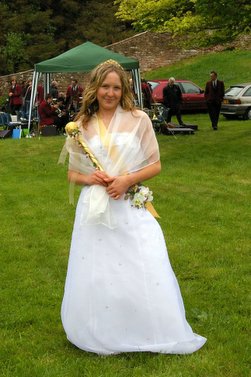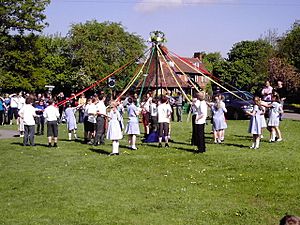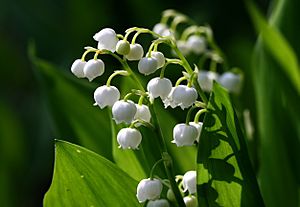May Day facts for kids
Quick facts for kids May Day |
|
|---|---|
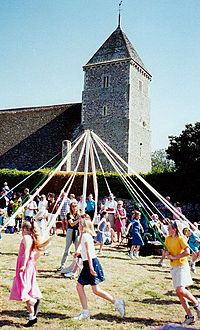
Maypole dancing at Bishopstone Church, East Sussex, in England, UK.
|
|
| Date | 1 May |
| Next time | 1 May 2026 |
May Day is a special day, often a public holiday, celebrated on May 1st. It is an old Northern Hemisphere spring festival and a traditional spring holiday in many cultures. Dances, singing, and cake are usually part of the fun.
In the late 1800s, May Day was also chosen as the date for International Workers' Day. This day honors workers and their rights, remembering an event in Chicago. So, while International Workers' Day is sometimes called "May Day," it is a different celebration from the older spring traditions.
Contents
What is May Day?
May Day has a long history, going back to ancient times. Some of its first celebrations were in Ancient Rome with a festival for Flora, the goddess of flowers. Other traditions come from ancient Germanic and Gaelic cultures, like the Beltane festival. For many old European cultures, May 1st was seen as the first day of summer, even though it is still spring for us!
As Europe became Christian, these old holidays changed. May Day became a popular, non-religious celebration. In Germany, it is linked to St. Walburga, who helped bring Christianity there.
The most famous May Day traditions in Europe and North America include dancing around a maypole and crowning a May Queen. Sometimes, people used to leave "May baskets" filled with sweets or flowers on neighbors' doorsteps, but this is less common now.
Since the 1700s, many Roman Catholics have honored Mother Mary during May. They might decorate her statues with flowers in a "May crowning." May 1st is also a feast day for St. Joseph the Worker, who was a carpenter and the foster father of Jesus. This date was chosen by Pope Pius XII in 1955 to be a religious day for workers, different from the International Workers' Day.
In recent times, some modern pagans have started celebrating May Day again as an ancient religious festival.
May Day in Europe
England
Traditional English May Day celebrations include crowning a May Queen and dancing around a maypole. Morris dancing is also often part of these events. Many of these customs come from old Anglo-Saxon and Celtic traditions.
May Day has always been a day of fun and parties in towns and villages. It celebrates the fertility of the land, animals, and people. Farmers had usually finished planting by this time, so it was a good day for farm workers to have a break. The maypole is a tall pole decorated with ribbons that dancers hold while circling it.
The first Monday in May is a public holiday in England, but May 1st itself is not, unless it falls on a Monday.
May Day celebrations were stopped for a while by the Puritans in the 1600s, but they came back when King Charles II returned to the throne in 1660.
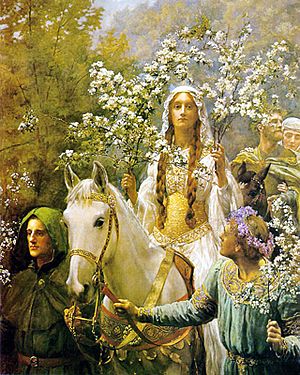
In Oxford, it is a very old tradition for people to gather at Magdalen College at 6 AM on May Morning. They listen to the college choir sing old songs. Since the 1980s, some people have jumped off Magdalen Bridge into the River Cherwell. However, the water is very shallow, and jumping can cause serious injuries. Because of this, the bridge is often closed on May 1st to keep people safe.
In Durham, students from the University of Durham meet on Prebend's Bridge to watch the sunrise. They enjoy folk music, dancing, singing, and a barbecue breakfast. This tradition started around 2001.
The May Day Festival in Kingsbury Episcopi, Somerset, has become very popular. It includes traditional maypole and morris dancing, along with modern music.
In Whitstable, Kent, the Jack in the Green festival was brought back in 1976. A procession of morris dancers goes through the town on the May bank holiday. A similar event started in Hastings in 1983. In Rochester, Kent, a traditional sweeps festival takes place, where the Jack in the Green is woken up at dawn on May 1st by Morris dancers.
Every year on May 1st at 7:15 PM, the Kettle Bridge Clogs morris dancing group dances across Barming Bridge near Maidstone. This marks the start of their morris dancing season.
The Maydayrun is an event where thousands of motorbikes travel about 55 miles (89 km) from London to the Hastings seafront. This event has been happening for almost 30 years and attracts many people. It is not officially organized, but the police help manage traffic.
Padstow in Cornwall has its yearly Obby-Oss (Hobby Horse) day. This is thought to be one of the oldest fertility rituals in the UK. People dance with the "Oss" through the streets and even into private gardens. They are joined by accordion players and followers in white clothes who sing the traditional "May Day" song. The whole town is decorated with spring greenery, and thousands of people come to watch.
Kingsand, Cawsand, and Millbrook in Cornwall celebrate the Flower Boat Ritual on the May Day bank holiday. A model of the ship The Black Prince is covered in flowers and taken in a procession. It is then set adrift in the sea. Houses are decorated with flowers, and people wear red and white clothes. There are also morris dancing and maypole dancing in Cawsand Square.
Scotland
May Day has been celebrated in Scotland for hundreds of years. It was once closely linked to the Beltane festival. An old poem from the 1400s describes a celebration in Peebles in the Scottish Borders. This town still has a parade and pageant each year, including the "Common Riding." A Beltane Queen is crowned, and people sing "The Beltane Song."
Scottish May Day and Beltane celebrations have become more popular again since the late 1900s. Both Edinburgh and Glasgow have May Day festivals. In Edinburgh, the Beltane Fire Festival is held on the evening before May Day on Calton Hill. Another old Edinburgh tradition says that young women who climb Arthur's Seat and wash their faces in the morning dew will be beautiful forever. At the University of St Andrews, some students gather on the beach on April 30th and run into the North Sea at sunrise on May Day. This is a joyful celebration with torchlit processions.
Wales
In Wales, May 1st is called Calan Mai or Calan Haf. It is similar to the Beltane festival and other May Day traditions in Europe.
Traditions would start the night before with bonfires. This night was considered a "spirit night" when people would gather hawthorn and flowers to decorate their homes. This celebrated new growth and fertility. On May Day itself, celebrations included summer dancing and May carols. May Day was also a time to officially open a village green for games and fun.
Finland
In Finland, Walpurgis Night (Vappu) is one of the four biggest holidays, like Christmas Eve and New Year's Eve. Vappu is the largest carnival-style festival in Finnish cities. The celebrations start on the evening of April 30th and continue on May 1st. People usually drink sima (a type of mead), sparkling wine, and other drinks.
Student traditions are a big part of Vappu. Many high school graduates wear black and white student caps, and university students wear special overalls. A common tradition is to drink sima and eat freshly cooked funnel cakes.
Estonia
May Day, or "Spring Day" (Kevadpüha), is a national holiday in Estonia that celebrates the arrival of spring.
More traditional parties happen throughout the night before and into the early hours of May 1st, during Walpurgis Night (Volbriöö).
France
On May 1st, 1561, King Charles IX of France received a lily of the valley flower as a good luck charm. He decided to give a lily of the valley to the ladies of his court every year. In the early 1900s, it became a custom to give a sprig of lily of the valley, which symbolizes springtime, on May 1st. The government allows people and workers' groups to sell them without tax on this day. Today, people often give loved ones bunches of lily of the valley or dog rose flowers.
Germany

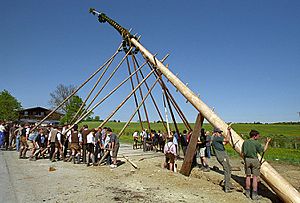
In rural parts of Germany, especially the Harz Mountains, Walpurgisnacht celebrations are held the night before May Day. These include bonfires and decorating a Maibaum (maypole). Young people use this night to party, and many families use May Day itself to enjoy the outdoors. The motto is "Tanz in den Mai" ("Dance into May").
In the Rhineland region, on May 1st, a maypole (a tree decorated with streamers) is delivered to a girl's house the night before. This tree is usually from someone who likes her. A tree wrapped only in white streamers means dislike. Women often place roses or rice shaped like a heart at their loved one's house. This is usually done secretly. In leap years, women are the ones who place the maypole.
May Day became a public holiday in Germany in 1933. As Labour Day, many political groups and unions hold events about work and jobs.
Ireland
May Day has been celebrated in Ireland since ancient times as the feast of Beltane and later as Mary's day. Traditionally, bonfires were lit to mark the start of summer and to end the long winter nights. The official Irish May Day holiday is the first Monday in May. Old traditions like bonfires are not as common now, but they still happen in some places.
Italy
In Italy, May Day is called Calendimaggio or cantar maggio. It is a seasonal festival that celebrates the arrival of spring. The name comes from the Latin calenda maia, meaning the beginning of May. Calendimaggio is still celebrated today in many regions of Italy. It represents the return to life and rebirth.
This old ritual often involves people singing good luck songs to the people in houses they visit, in exchange for gifts like eggs, wine, food, or sweets. These songs are often love songs, celebrating spring. Symbols of spring are trees like the alder and flowers like violets and roses. The alder tree, which grows by rivers, is seen as a symbol of life.
Calendimaggio has roots in ancient peoples like the Celts (who celebrated Beltane), Etruscans, and Ligures. For them, the arrival of summer was very important.
Greece
May 1st in Greece celebrates Spring.
Maios, the month of May, was named after the goddess Maia, a Greek and Roman goddess of fertility. May 1st (Modern Greek Πρωτομαγιά) celebrates summer's victory over winter, and life's victory over death. It is similar to an ancient ritual for the god Adonis, which also celebrated nature coming back to life.
A common modern May Day custom is to make a flower wreath from wild flowers. These wreaths are hung on the entrance of homes or on balconies. They stay there until midsummer night. On that night, the flower wreaths are burned in bonfires called St. John’s fires. Young people used to jump over these flames. However, this custom has mostly disappeared in cities.
Bulgaria
On May Day, Bulgarians celebrate Irminden. This holiday is linked to snakes and lizards, and rituals are done to protect people from them. The name comes from the prophet Jeremiah, but its origins are likely much older.
It is believed that on this day, the king of snakes comes out of its burrow. Old people think that those who work in the fields on this day will be bitten by a snake in summer.
In western Bulgaria, people light fires, jump over them, and make noise to scare away snakes. Another custom is to prepare special clay pots for baking bread.
This day is especially important for pregnant women. They avoid working to protect their children from an illness caused by evil spirits.
Romania
On May Day, Romanians celebrate arminden. This marks the beginning of summer and is linked to protecting crops and farm animals. The name comes from a Slavic word meaning prophet Jeremiah's day, but the celebrations are much older and likely come from pagan traditions.
The day is also called "mugwort day" or "drunkards' day." It is celebrated to ensure good wine in autumn and good health for people and animals. People have parties outdoors, often with musicians. It is customary to roast and eat lamb, along with new cheese, and to drink mugwort-flavored wine or red wine. This is believed to refresh the blood and protect against diseases. Men often wear lilac or mugwort flowers on their hats when they return home.
Other protective rituals include washing faces with morning dew for good health. People also decorate gates with green branches or birch saplings for good luck and plenty. These branches stay until the wheat harvest, when they are used to bake the first bread from the new wheat.
On May Day eve, women in the countryside do not work in the fields or at home. This is to avoid bad storms and hail.
Arminden is also "oxen day," so these animals are not used for work. If they are, it is believed they could die or their owners could get sick.
It is said that the weather is always good on May Day so people can celebrate.
Portugal
"Maias" is a tradition in Portugal, especially in the northern parts. People put yellow flowers from Portuguese broom bushes, called giestas or Maias, on doors, gates, windows, and even cars. They collect these flowers on the evening of April 30th when the bushes are blooming. This is done to protect these places from bad spirits, witches, and the evil eye. The flowers must be placed before midnight.
These celebrations are similar to "Os Maios" in Galicia. In the past, this was done while playing traditional night music. In some places, children dressed in these flowers and went around asking for money or bread. On May 1st, people also used to sing "Cantigas de Maio," which are traditional songs about this day and the month of May.
Serbia
"Prvomajski uranak" (Reveille on May 1st) is a tradition in Serbia. On May 1st, people go out into nature, or even leave the day before and spend the night camping with a bonfire. They often cook food in a kettle or on a barbecue. This holiday is very popular in Serbia. Almost every town has its own traditional outdoor spots for May 1st trips, usually green areas outside the city.
Spain
May Day is celebrated throughout Spain as Los Mayos (meaning "the Mays"). It is often similar to the "Fiesta de las Cruces" in many parts of Latin America. For example, in Galicia, the festival involves different displays around a decorated tree or sculpture. People sing popular songs, also called maios, which talk about social and political events from the past year. They walk around the sculpture, tapping two sticks together for rhythm. Today, it is often a competition where the best sculptures and songs win prizes.
In the Galician city of Ourense, this day is traditionally celebrated on May 3rd, the day of the Holy Cross.
Sweden
The more traditional May Day parties have moved to the day before, Walpurgis Night ("Valborgsmässoafton"). May 1st itself is celebrated as International Workers' Day.
Poland
In Poland, May 1st is a state holiday. It is celebrated as May Day, but because of its history, most celebrations are focused on Labour Day festivities. It is common for workers' groups and left-wing political parties to organize parades in cities and towns across Poland on this day. The holiday is also often called "Labour Day" (Święto Pracy).
In Poland, May Day is followed closely by May 3rd Constitution Day. These two dates often create a long weekend called "Majówka." People often travel, and "Majówka" is unofficially considered the start of the barbecue season in Poland. On May 2nd, there is also a patriotic holiday, the Day of the Polish Flag.
Czech Republic
In the Czech Republic, May Day is traditionally seen as a holiday of love, and May is considered the month of love. Spring celebrations are held on April 30th when a maypole (májka) is put up. This tradition might be connected to Beltane, as bonfires are also lit on that day. This event is similar to the German Walpurgisnacht. April 30th is a public holiday.
On May 1st, couples in love often kiss under a blooming tree. A cherry, apple, or birch tree is usually chosen for this.
May Day in North America
Canada
May Day is celebrated in some parts of the Canadian provinces of British Columbia, New Brunswick, and Ontario.
Toronto In Toronto, on the morning of May 1st, various Morris Dancing groups from Toronto and Hamilton gather in High Park to "dance in the May." The dancers and crowd then sing traditional May Day songs.
British Columbia Celebrations often happen not on May 1st, but during the Victoria Day long weekend, later in the month, when the weather is usually better. The longest continuously celebrated May Day in the British Commonwealth is in New Westminster, BC. Their first May Day celebration was on May 4th, 1870.
United States
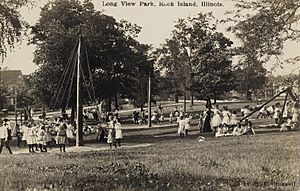
May Day was also celebrated by some early European settlers in the American continent. In some parts of the United States, people make May baskets. These are small baskets usually filled with flowers or treats and left at someone's doorstep. The person who leaves the basket rings the bell and runs away.
Modern May Day ceremonies in the U.S. vary a lot. Many combine both the old spring traditions and the "Red Root" (labor) traditions.
May Day celebrations were common at women's colleges in the late 1800s and early 1900s. This tradition continues today at Bryn Mawr College and Brenau University.
In Minneapolis, the May Day Parade and Festival is held every year by the In the Heart of the Beast Puppet and Mask Theatre on the first Sunday in May. It attracts about 50,000 people to Powderhorn Park.
Hawaii
In Hawaii, May Day is also known as Lei Day. It is a day to celebrate island culture, especially the culture of the Native Hawaiians. The first Lei Day was celebrated on May 1st, 1927, in Honolulu. The song "May Day Is Lei Day in Hawai'i" is the traditional holiday song.
Images for kids
See also
 In Spanish: Festividad de los Mayos para niños
In Spanish: Festividad de los Mayos para niños


